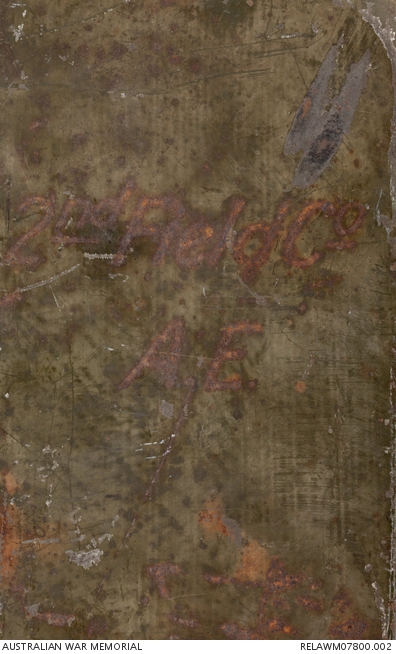| Place | Middle East: Ottoman Empire, Turkey, Dardanelles, Gallipoli, Bolton's Ridge, Shell Green |
|---|---|
| Accession Number | RELAWM07800.002 |
| Collection type | Technology |
| Object type | Optical equipment |
| Physical description | Linen paper |
| Maker |
Unknown |
| Place made | United Kingdom: England |
| Date made | 1919 |
| Conflict |
First World War, 1914-1918 |
Australian War Records Section label, Trench Periscope : Shell Green, Gallipoli


An original fabric Australian War Records Section collection label. It is tied to the periscope by a piece of string. The front of the label printed text, with blank spaces filled in by hand in graphite pencil. It reads, in part: 'AUSTRALIAN WAR MUSEUMS / Giver Historic Mission / Unit [blank] Town of enlistment [blank] / Date found Jany 1919 Place found Shell Green / Particulars of exhibit, finding, etc., Periscope of 2nd Field Co Eng / found on Shell Green'.
The back of the label reads: 'On His Majesty's Service / TO COLLECTION DEPOT / AUSTRALIAN WAR MUSEUMS, / C/O HEADQUARTERS, / AUSTRALIAN CORPS. / Note: collecting Depot is situated as shewn in / corps and Divisional Routine Orders.'
This damaged periscope was found in January 1919 by Lieutenant William Hopkin James, who was working on Gallipoli, leading a small party from the Australian War Records Section, taking photographs and collecting items for the national collection. It was located, together with a megaphone (RELAWM00338), at Shell Green.
The periscope was used by members of the 2nd Field Company Engineers at Gallipoli, who landed at Anzac Cove at 7am on 25 April 1915, and, excluding some periods in camp at Lemnos, served at Gallipoli until December, with the last sections of the unit departing on the morning of 19 December.
At Gallipoli, the unit did much work building trenches, tunnels, shelters and other facilities around the Anzac area, including Shrapnel Gully, Lone Pine and Leane's Trench. They also assisted in the December evacuation by preparing the beach area for the departing troops (including the placements of sandbags on piers to muffle the sound of the soldiers' feet) and completing demolition work on material that had to be left behind.